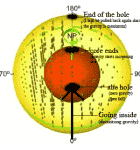Varun
ICC Board Member
- Joined
- Mar 14, 2009
- Location
- Delhi, India
- Online Cricket Games Owned
- Don Bradman Cricket 14 - Steam PC
Suppose sinA = sinB = 1, then cos A = cos B = 0 (A = B = 90degrees). But then you could have sinC = -1, and cos C = 0 (C = 270degrees)
Then sinA + sinB + sinC = 1 and cosA + cosB + cosC = 0
Are there more possibilities?





